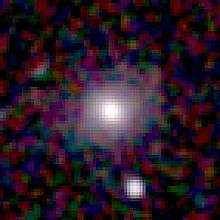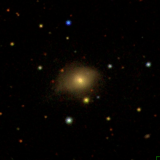NGC 5
| NGC 5[1] | |
|---|---|
 NGC 5 (2MASS) | |
| Observation data (J2000 epoch) | |
| Constellation | Andromeda |
| Right ascension | 00h 07m 48.872s |
| Declination | +35° 21′ 44.3″ |
| Redshift | 5111 ± 41 km/s |
| Distance |
212 Mly Redshift-based |
| Apparent magnitude (V) | 14.33[1] |
| Characteristics | |
| Type | E |
| Apparent size (V) | 1.2′ × 0.7′[1] |
NGC 5 (also MCG 6-1-13, UGC 62 and PGC 595) is an elliptical galaxy in the constellation Andromeda. It has a generic "redshift estimated" distance of 212 million light years from Earth. The galaxy was discovered by French astronomer Edouard Stephan using an 80.01 cm (31.5-inch) reflecting telescope at the Marseille Observatory on 21 October 1881.[2]
 NGC 5 on Aladin Sky Atlas
NGC 5 on Aladin Sky Atlas NGC 5 by Sloan Digital Sky Survey
NGC 5 by Sloan Digital Sky Survey
General
Observation data
The galaxy's position on the sky is RA 00h 07m 49s, Dec +35° 21' 44.3'', just 0.2 arcmin west of the nucleus of NGC 4. As a magnitude 14 galaxy, its nucleus is very small and faint, equivalent to a 13th or 14th magnitude star.
Physical information
NGC 5 has an estimated distance of 212 million light years from Earth. It is about 80 thousand light years across.
References
- 1 2 3 "NASA/IPAC Extragalactic Database". NED Search Results for NGC 0005. Retrieved 2007-10-29.
- ↑ "New General Catalog Objects: NGC 1 - 49". cseligman.com. Retrieved 2017-09-21.
External links
| Wikimedia Commons has media related to NGC 5. |
- NGC 5 on WikiSky: DSS2, SDSS, GALEX, IRAS, Hydrogen α, X-Ray, Astrophoto, Sky Map, Articles and images
This article is issued from
Wikipedia.
The text is licensed under Creative Commons - Attribution - Sharealike.
Additional terms may apply for the media files.